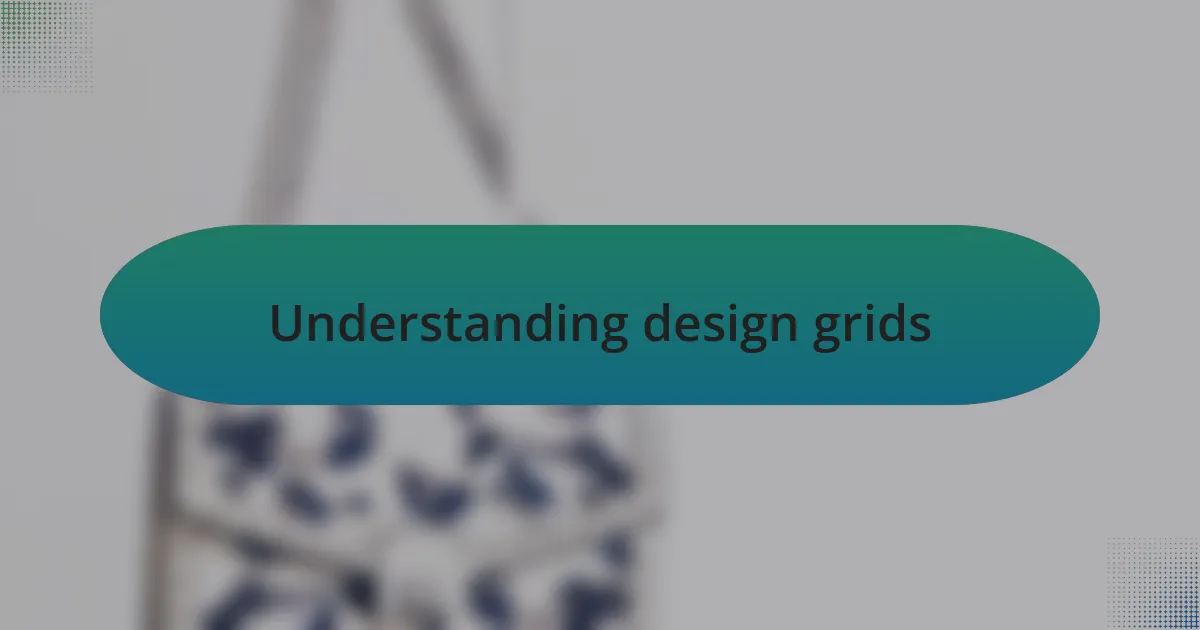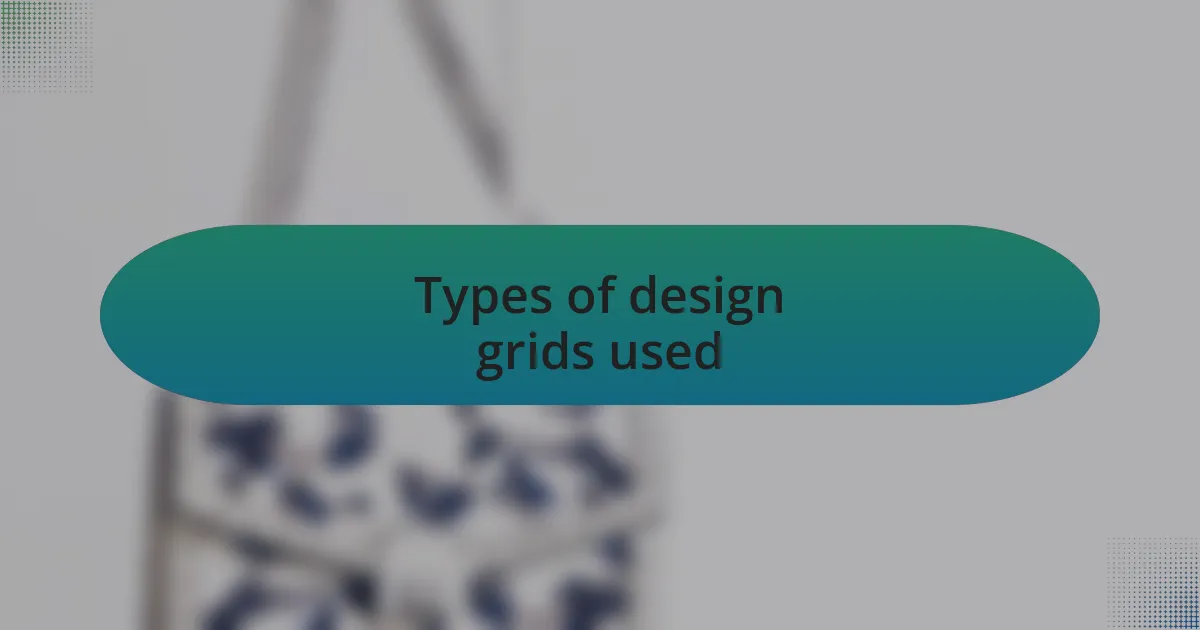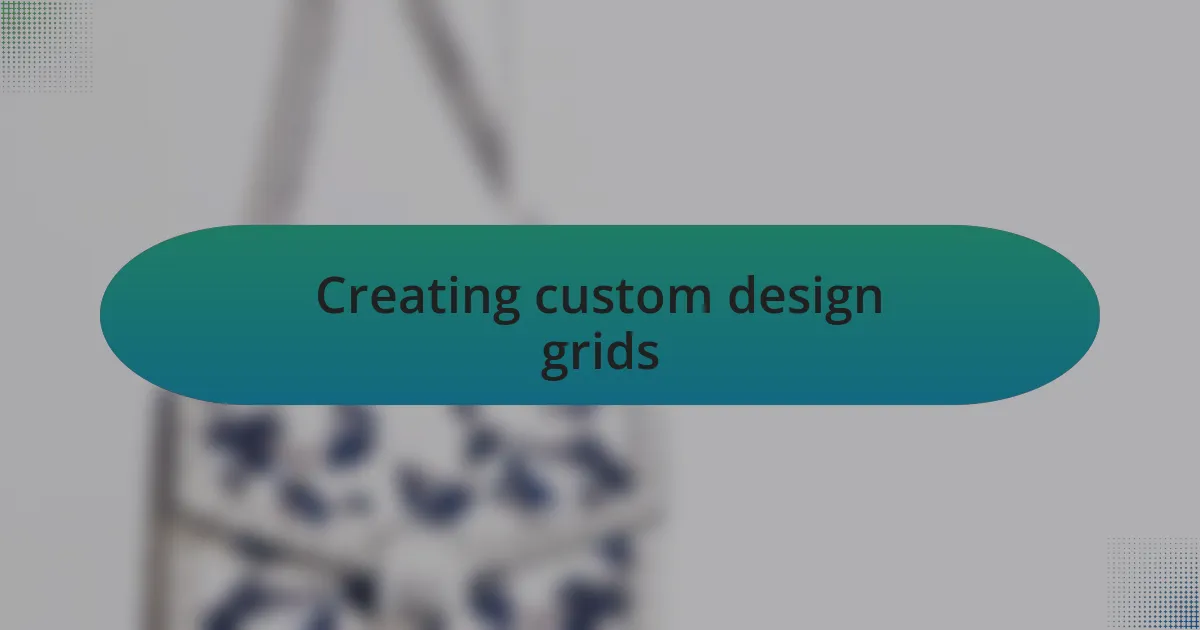Key takeaways:
- Design grids enhance visual harmony and guide the reader’s attention by providing a structured framework for content placement.
- Different types of grids, such as column, modular, and baseline grids, serve unique purposes in arranging elements for effective storytelling.
- Creating custom design grids allows for personalized layouts that can reflect themes and enhance the overall narrative of the content.
- Whitespace plays a crucial role in design, as it helps improve readability and emphasizes key visuals, contributing to a sophisticated aesthetic.

Understanding design grids
Design grids are essential tools that help structure content on a page, ensuring visual harmony and balance. I remember the first time I used a grid layout on my fashion blog; it transformed my chaotic ideas into a cohesive presentation that guided my readers’ eyes seamlessly. Have you ever felt overwhelmed by the clutter on a webpage? Grids can eliminate that confusion by creating a clear pathway through the information.
When I first discovered the power of design grids, I felt like I had unlocked a new level in my design skills. They provide a framework that allows me to emphasize key elements, such as bold fashion images or striking typography. Imagine being able to effortlessly guide your reader’s attention; that’s what a well-implemented grid does.
Understanding design grids goes beyond just placement; it’s about creating a rhythm that resonates with your audience. I often ask myself, “How does each element contribute to the overall experience?” This kind of reflective thinking fosters a deep connection with your design, making it a crucial aspect of my creative process. I know that when I harness the potential of design grids, the result speaks to both me and my audience.

Types of design grids used
When diving into the various types of design grids, I often lean towards the column grid. This format divides the page into several vertical sections, allowing different elements to align neatly. I recall using a column grid for a seasonal lookbook, where each column highlighted a different outfit. It was fascinating to see how the structured layout enhanced the visual appeal, guiding the eye effortlessly from one outfit to the next. Have you ever noticed how a column layout can create a sense of order amidst the creative chaos?
Another popular choice is the modular grid, which breaks the page into a series of uniform blocks. I first experimented with this style when I wanted to showcase multiple fashion pieces in a gallery format. The modular grid allowed me to create a visually engaging arrangement, making each item stand out while still feeling part of a cohesive whole. It sparked a question for me: how can simple shapes amplify the storytelling in fashion design?
Lastly, there’s the baseline grid, a more refined approach that focuses on consistent vertical spacing for text and images. I implemented this grid when working on my blog’s typography, ensuring that each line of text aligned perfectly. This choice not only elevated the readability of my posts but also helped establish a polished, professional look. Isn’t it interesting how alignment can significantly influence the overall aesthetics of your design?

Creating custom design grids
Creating custom design grids allows for a more personalized approach to showcasing content. I remember when I tailored a grid specifically for a spring collection reveal. By creating a layout that reflected the collection’s theme, I was able to infuse elements of nature, like floral patterns, which complemented the designs beautifully. It made me wonder, how often do we overlook the power of a grid in enhancing our narrative?
A key aspect of custom grids is versatility. I once built a diagonal grid for a blog post that highlighted emerging trends. The slanted lines drew attention and contributed a dynamic feel to the images, capturing the essence of movement in fashion. Have you ever tried playing with angles in your designs and found that it invigorates the overall presentation?
Experimentation is at the heart of creating effective design grids. I recall a time when I combined elements of both column and modular grids for an interactive lookbook that showcased my favorite designers. The result was astonishing; it sparked an engaging conversation among my readers about the fusion of structure and creativity. Isn’t this blend of order and imagination what truly sets fashion design apart?

Personal experience with design grids
There was a time when I first ventured into using a grid for a fashion editorial piece. The initial structure felt somewhat rigid, but then I realized that the grid actually provided a framework I could play within. It was as if I found a canvas that encouraged my creativity rather than restricting it. Have you ever experienced that moment when a design element suddenly dawns on you as a supportive ally rather than just a guideline?
As I practiced more with design grids, I discovered the power of whitespace. I remember rearranging elements on my grid to allow for breathing room around certain images, particularly with outfit showcases. This not only made the visuals pop but also helped convey the sophistication of the designs. It got me thinking: how often do we chase clutter when, in fact, simplicity could elevate our work much more?
One memorable project involved designing a seasonal lookbook where I decided to implement a modular grid with unexpected asymmetries. The balance of chaos and order created an exciting visual rhythm that resonated with the vibrant energy of the designs. I felt exhilarated when my audience responded positively, proving that taking risks within a structured format could lead to something beautiful. Have you dared to step off the beaten path with your grids, only to find magic waiting there?